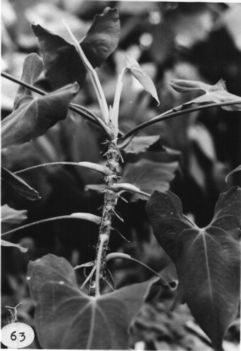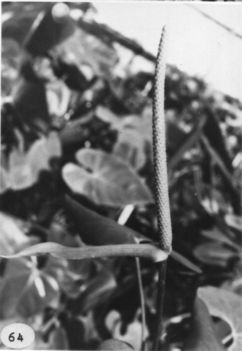



Anthurium folsomianum Croat, sp. nov.
TYPE: Panama. Panama: vicinity off Cerro Jefe, 4.6 km beyond peak on road to Altos de Pacora, 26.3 km from Pan-American Hwy., ca. 600 m, Croat 35918 (MO 2381194, holotype; PMA, isotype).
Planta epiphytica aut terrestris; cataphyllum persistens intactum denique deciduum; petiolus teres aut obscure et anguste sulcatus, 8-19 cm longus, lamina subcoriacea anguste ovata ad ovato-triangulata, basi cordata, 12-22 cm longa, 7-13 cm lata; inflorescentia erecta ad effusa; pedunculus teres, 18-30 cm longus; spatha membranacea, viridis, oblongo-lanceolata, 5-10 cm longa, 11-15 mm lata; spadix viridis, 5.7-12 cm longus; baccae atropurpureae, ovoidae, apice anguste rotundae.
Epiphyte or terrestrial; stem creeping or erect, to ca. 1m long, slender, brittle; internodes 1-7 cm long; leaf scars 1-1.5 cm diam.; roots 3-5 per node; cataphylls ca. 2.5 cm long, drying light tan, briefly persisting intact, then deciduous.
LEAVES persisting at upper 5-6 nodes; petioles terete or obscurely and narrowly sulcate, 8-19 cm long, to 2.5 cm diam.; geniculum ca. 1 cm long; blades narrowly ovate to ovate triangular, subcoriaceous, long-acuminate at apex (the acumen moderately flat and apiculate), lobed at base, 12-22 cm long, 7-13 cm wide, broadest near the base; anterior lobe 11-15 cm long, the sides straight to weakly convex; posterior lobes 5-8 cm long (from apex of sinus to outermost point); sinus parabolic or hippocrepiform, obtuse to round at apex; both surfaces matte, upper surface velvety; the midrib acutely raised above and below, basal veins 4÷6 pairs, 3-5 of them coalesced 1.5-4 cm; flat to prominulous above and below; primary lateral veins 6-7 per side, departing midrib at 40-50¡ degree angle, straight to collective vein, flat above, prominulous below, obscure above, darker than surface below, lesser veins obscure above, visible below; collective vein arising from the first basal vein, 3-10 mm from margin.
INFLORESCENCE erect to spreading; peduncle 18-30 cm long, 2-5 mm diam., terete, longer than the petioles; spathe green, moderately thin, oblong-lanceolate, 5-10 cm long, 11-15 mm wide, broadest near the base, acuminate at apex, rounded at the base, inserted at ca. 40¡ angle on peduncle, the sides sometimes rolled under; stipe 1-3 mm long; spadix green, 5.7-12 cm long, 4÷6 mm diam.; flowers rhombic, 2-2.2 mm long (dried), 1.7-1.8 mm wide, 5-7 flowers visible in the principal spiral; tepals semiglossy, drying with a few conspicuous raphide cells clearly visible, lateral tepals 1.2-1.6 mm diam., the inner margin broadly rounded; pistil not emergent; stamens emerging from the base in a relatively complete sequence with the lateral stamens preceding the alternates by only a few spirals; anthers ca. 0.8 mm long, 1 mm wide (dried), held just above the tepals and inclined inward over the pistil;thecae narrowly ovate, scarcely divaricate; pollen white.
INFRUCTESCENCE spreading; spathe persistent; spadix to ca. 15 cm long, 2.5 cm diam.; berries dark violet purple, ovoid, exserted and colored before maturity, narrowly rounded at apex; seeds not studied. Figs. 63 and 64.
Anthurium folsomianum is endemic to the Cerro Jefe region at 600 to 1,000 m in premontane rain forest. This attractive species is named in honor of James Folsom for his important role in providing many living collections of Panamanian aroids. Mention should also be made of the assistance of Dr. H. Kamemoto at the University of Hawaii who was the first collector of the species. Some of the details of the description were based on live plants at the University of Hawaii where the species is in cultivation (Kamemoto 276, 280).
The species is tentatively placed in section Cardiolonchium because of its velvety leaf blades but it shows little relationship to other members of the section in Panama, namely Anthurium dressleri and A. papillilaminum. In terms of its habit it might be more easily confused with A. hutchisonii (which dries blackened rather than green) or A. leptocaule. The latter differs in drying brown (rather than green as in A. folsomianum) and in having posterior lobes usually rounded or at least not much longer than broad (versus almost twice as long as broad in A. folsomianum).
The species is distinguished by its slender, gray, brittle stem, often with elongate internodes near the base, by its narrowly ovate-triangular, velvety leaves that are paler beneath with the veins darker than the matte surface, and by the slightly tapered green spadix, green lanceolate spathe, and violet purple berries.
 |
 |
Map of Mesoamerican specimens with coordinates
Panama Panamá: Cerro Jefe,, , Croat 73980 (MO).
Panama Panamá: Cerro Jefe, 750-800 m, 9.14N 79.22W, , Thomas B. Croat 67086 (MO, WU).
Panama Panamá: Cerro Jefe,, 11 Dec. 1978, Thomas B. Croat 45062 (MO).